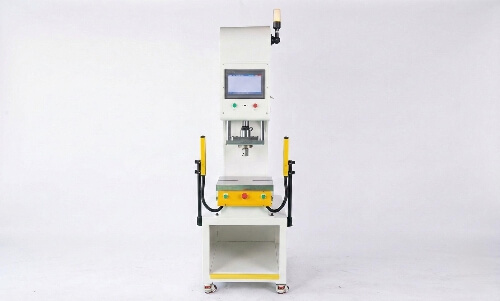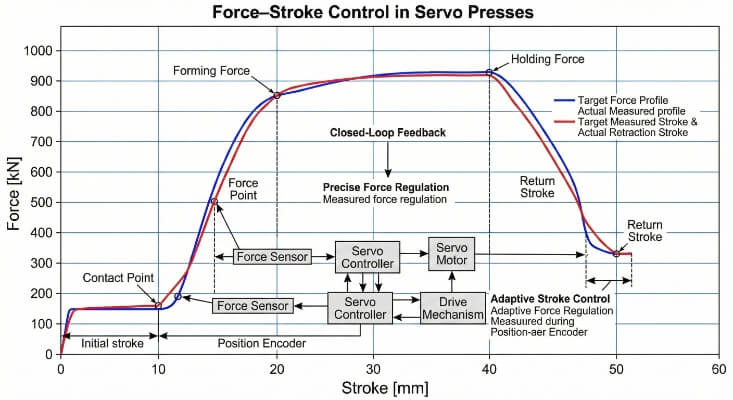금속 가공에서는 절단과 굽힘이 가장 많은 관심을 받습니다. 하지만 부품의 강도와 외관을 실제로 결정하는 것은 이러한 단계 이후에 이루어지는 마감 처리입니다. 적절한 표면 처리는 일반 부품을 녹과 마모, 오랜 사용으로 인한 영향에 견디는 부품으로 바꿀 수 있습니다. 그렇지 않으면 잘 만들어진 부품도 조기에 고장날 수 있습니다.
판금 마감과 코팅은 열악한 환경으로부터 부품을 보호합니다. 성능을 향상시키고 외관을 개선하며 시간이 지나도 부품의 신뢰성을 유지합니다. 부품을 설계하거나 부품을 구매하거나 생산을 관리할 때 올바른 마감재를 선택하면 내구성과 품질에 큰 영향을 미칠 수 있습니다.
이 문서에서는 파우더 코팅, 아노다이징, 전기 도금 및 패시베이션을 포함한 몇 가지 표준 마감 및 코팅 방법을 살펴봅니다. 각 방법에는 고유한 장점이 있습니다. 다양한 마감 처리가 강도, 내식성 및 외관에 어떤 영향을 미치는지 이해하면 제품의 성능과 수명을 향상시키는 보다 현명한 선택을 할 수 있습니다.
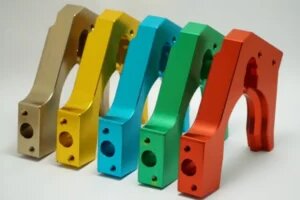
판금 마감이란 무엇인가요?
판금 마감은 부품의 외관, 강도 및 성능을 향상시키는 제조의 마지막 단계입니다. 금속 표면을 처리하기 위해 기계적, 화학적 또는 전기화학적 방법을 사용합니다. 이러한 프로세스를 통해 사소한 결함을 제거하고 거친 부분을 매끄럽게 하며 코팅이나 페인트를 칠할 수 있도록 부품을 준비합니다. 또한 마감 처리는 녹, 부식 및 표면 마모를 방지하는 보호 층을 추가합니다.
마감 처리를 잘하면 베어 메탈을 장기간 사용할 수 있는 부품으로 만들 수 있습니다. 습하거나 실외 환경에서 산화를 막고 움직이는 부품 간의 마찰을 줄일 수 있습니다. 또한 마감 처리를 하면 부품을 더 쉽게 청소할 수 있고 외관을 더 오래 유지할 수 있습니다.
판금 마감의 일반적인 유형
각 마감 방법은 부품의 기능과 작업 환경에 따라 고유한 강점을 가지고 있습니다. 다음은 판금 부품에 사용되는 가장 인기 있고 효과적인 마감 방법 중 일부입니다.
비드 블라스팅
비드 블라스팅 은 섬세한 유리 구슬과 압축 공기를 사용하여 금속 표면을 깨끗하고 매끄럽게 만듭니다. 이 공정은 부품의 정확한 치수를 유지하면서 녹, 산화, 가공 자국을 제거합니다. 약 Ra 1.0~3.0 μm의 거칠기를 가진 무광택 또는 새틴 표면을 생성하여 추후 코팅 또는 페인팅에 적합한 베이스를 만듭니다.
스테인리스 스틸, 알루미늄 및 연강에 자주 사용됩니다. 비드 블라스팅은 코팅 접착력을 향상시키고 부품에 깨끗하고 균일한 외관을 제공하여 사소한 표면 결함을 숨깁니다. 일관된 외관과 미세한 질감이 필요할 때 탁월한 선택입니다.
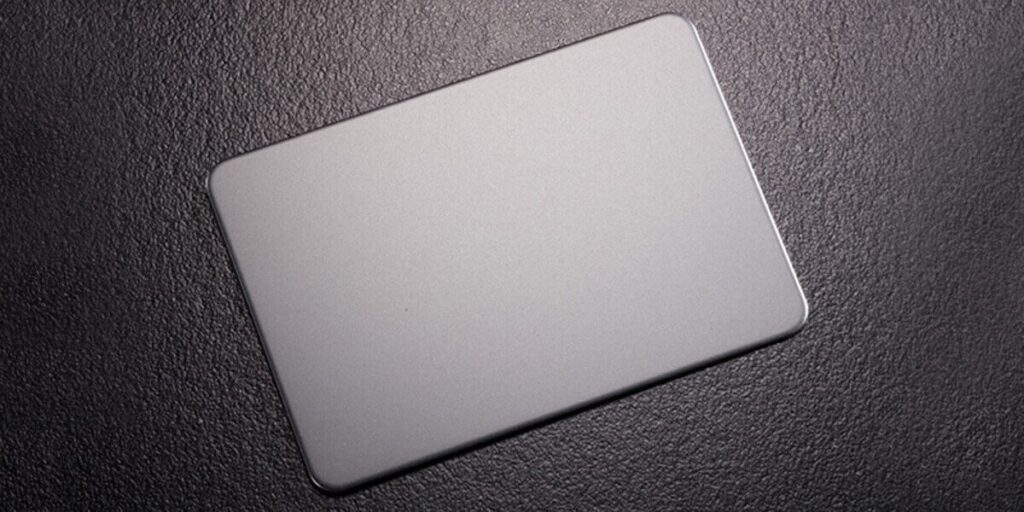
분말 코팅
분체 도장 는 하전된 분말 입자를 접지된 금속 표면에 분사한 다음 180~200°C의 오븐에서 경화시킵니다. 녹은 파우더는 60~120μm 두께의 지속적이고 내구성 있는 필름을 형성합니다.
이 코팅은 부식, 충격 및 자외선 손상으로부터 탁월한 보호 기능을 제공하므로 실내 및 실외에 모두 적합합니다. 파우더 코팅 부품은 수년간 색상과 광택을 유지하며 변색이나 벗겨짐이 최소화됩니다. 수많은 색상과 질감 중에서 선택할 수 있는 이 마감은 강도와 시각적 매력을 모두 필요로 하는 인클로저, 가구 및 기계 부품에 널리 사용됩니다.
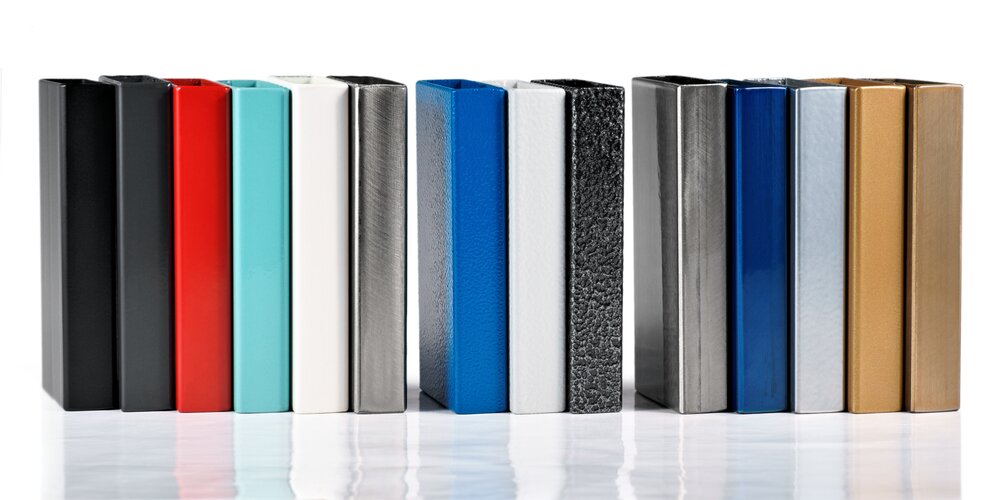
그림
그림 금속을 보호하고 색상을 추가하기 위해 30~50μm의 얇은 액체 코팅층을 추가합니다. 표면을 청소하고 때로는 페인트의 접착력을 높이기 위해 인산염 층으로 처리하기도 합니다. 그런 다음 부품을 120~150°C에서 구워 페인트를 경화시키고 내구성을 높입니다.
목적에 따라 다른 페인트를 사용합니다:
- 에폭시 페인트 는 강력한 내화학성을 제공하며 산업용 기계에 적합합니다.
- 아크릴 페인트 는 건조가 빠르며 실내 가구나 디스플레이에 적합합니다.
- 폴리우레탄 페인트 햇빛과 비를 견딜 수 있어 야외에서 사용하기에 이상적입니다.
페인팅은 색상과 마감 옵션이 유연하고 프로토타입이나 소량 생산에 비용 효율적입니다. 파우더 코팅만큼 견고하지는 않지만 표면이 매력적이고 청소하기 쉬우며 날씨에 대한 보호 기능이 뛰어납니다.
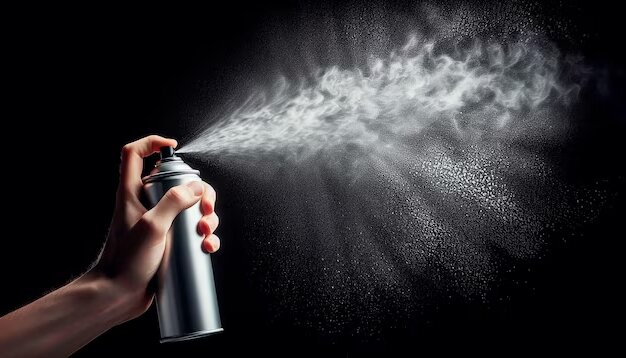
전기도금
전기도금 는 전류를 사용하여 아연, 니켈 또는 크롬과 같은 다른 금속의 얇은 층으로 부품을 코팅합니다. 코팅의 두께는 보통 2~25μm입니다.
- 아연도금 은 내식성과 반짝이는 은색 외관을 제공합니다.
- 니켈 도금 경도와 내마모성을 추가합니다.
- 크롬 도금 는 높은 내구성을 갖춘 거울과 같은 마감을 제공합니다.
전기 도금 부품은 외관과 성능이 모두 중요한 자동차, 전자 및 장식용 제품에 일반적으로 사용됩니다.
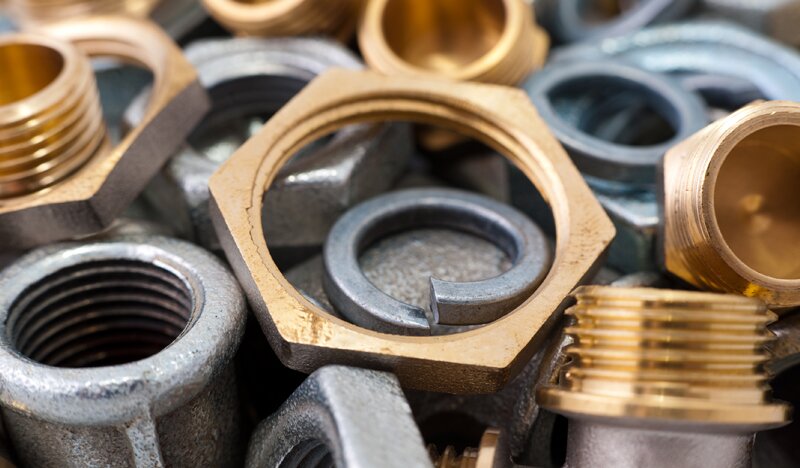
아노다이징
아노다이징 은 내식성과 표면 경도를 향상시키기 위해 주로 알루미늄에 사용됩니다. 알루미늄 부품을 산성 욕조에 넣고 전류를 흐르게 하면 10~100㎛ 두께의 단단한 산화물 층이 형성됩니다.
아노다이징 알루미늄은 다양한 색상으로 염색할 수 있습니다. 염료가 산화물 층에 흡수되기 때문에 깨지거나 벗겨지지 않습니다. 그 후 뜨거운 물로 표면을 밀봉하여 기공을 닫고 색상을 고정합니다.
- 타입 II 아노다이징 (황산)은 소비자 및 건축용으로 일반적으로 사용됩니다.
- 타입 III 아노다이징하드 아노다이징이라고도 하는 이 공정은 항공우주 및 산업용 부품에 더 두껍고 단단한 층을 만듭니다.
아노다이징 부품은 또한 강력한 전기 절연성을 제공하므로 하우징, 방열판 및 전자 부품에 적합합니다.

패시베이션 및 화학 필름
패시베이션은 표면에서 유리 철과 불순물을 제거하여 스테인리스 스틸의 내식성을 향상시킵니다. 부품의 외관을 변경하지 않고 얇고 눈에 보이지 않는 산화막을 형성합니다.
알루미늄의 경우 크롬산염 변환과 같은 화학 필름 코팅이 비슷한 보호 기능을 제공합니다. 이러한 코팅은 일반적으로 1μm 미만으로 깨지기 쉬우며 산화에 저항하면서 전기 전도성을 유지합니다. 두 가지 처리 방식 모두 전도성과 내식성이 필수적인 인클로저 및 전기 어셈블리에 일반적으로 사용됩니다.
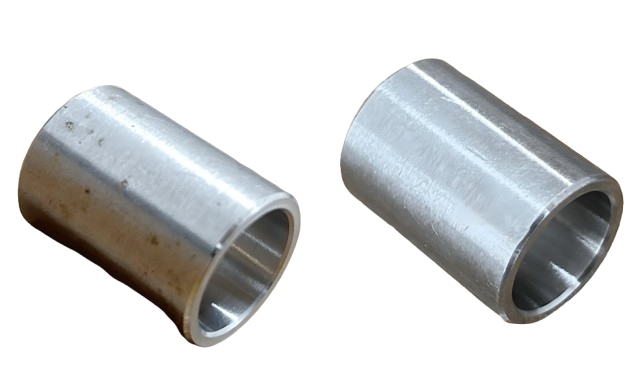
E-코팅
전자 코팅, 전기 영동 코팅이라고도 함는 전기장을 사용하여 페인트를 고르게 도포합니다. 부품을 수성 페인트 욕조에 담그고 충전한 다음 160~190°C에서 구워냅니다. 최종 코팅의 두께는 일반적으로 20~35μm이며 복잡한 모양과 좁은 모서리까지 커버합니다.
E-코팅은 우수한 내식성과 함께 매끄럽고 광택 있는 마감을 제공합니다. 일관된 커버리지, 강력한 접착력, 칩핑과 변색에 대한 저항성을 제공하기 때문에 자동차 및 가전 제품 생산에 널리 사용됩니다.
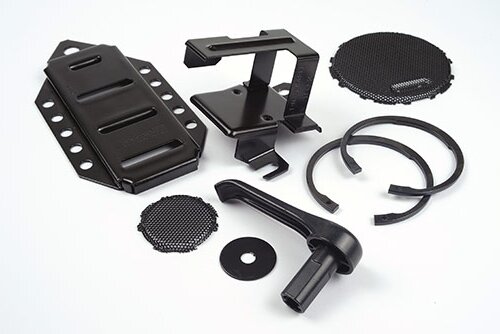
뜨거운 흑화
흑색 산화물 코팅이라고도 하는 고온 흑화는 강철이나 철에 얇은 검은색 층을 형성합니다. 부품을 일련의 가열된 화학 용액에 담가 약 1μm 두께의 산화물 층을 만듭니다.
이 마감은 가벼운 부식 방지 기능을 제공하고 눈부심을 줄이며 균일한 어두운 외관을 제공합니다. 일반적으로 치수를 정확하게 유지하면서 깔끔하고 전문적인 외관을 필요로 하는 공구, 패스너 및 정밀 부품에 사용됩니다.
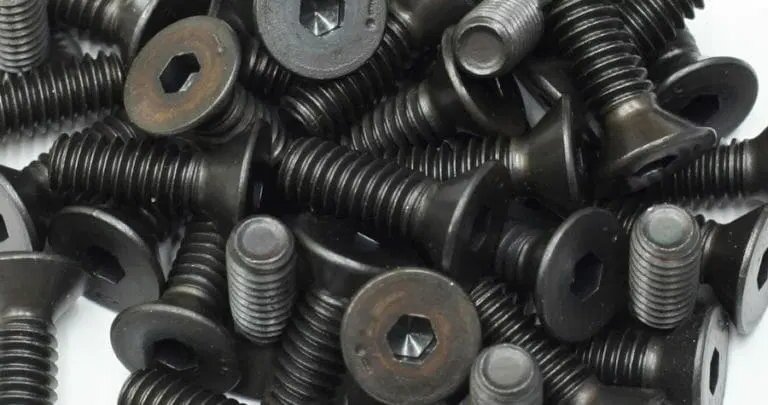
판금 마감으로 성능을 향상시키는 방법?
표면 마무리 표면 처리는 부품을 보기 좋게 만드는 것 이상으로 부품의 성능과 수명에 직접적인 영향을 미칩니다. 각 표면 처리 유형은 부품을 보호하고 장기적인 비용을 최소화하는 데 중요한 역할을 합니다.
부식 및 내마모성
금속 부품은 습기, 화학물질, 마찰 등 가혹한 환경에 노출되는 경우가 많습니다. 적절한 마감 처리를 하지 않으면 이러한 요인으로 인해 녹, 산화 또는 표면 마모가 발생할 수 있습니다. 파우더 코팅, 아노다이징, 전기 도금과 같은 마감 처리는 이러한 문제를 방지하는 보호막을 형성합니다. 예를 들어 파우더 코팅된 강철 인클로저는 수년간 야외 날씨에 견딜 수 있으며, 양극산화 처리된 알루미늄은 습한 환경이나 해양 환경에서도 안정적으로 유지됩니다.
마감 처리는 반복적인 접촉이나 움직임으로 인한 기계적 마모로부터도 보호합니다. 하드 아노다이징과 니켈 도금은 표면을 더욱 복잡하게 만들고 긁힘이나 마모에 대한 저항력을 높입니다. 표면 마감은 부식과 마모를 줄임으로써 부품의 수명을 연장하고 유지보수 비용을 낮춰 생산과 일상 사용 모두에서 중요한 이점을 제공합니다.
미적 및 브랜딩 효과
고품질 마감은 제품에 전문적이고 가치 있는 외관을 부여합니다. 매끄럽고 균일한 코팅은 부품의 정확성과 내구성을 높여 브랜드에 대한 고객의 신뢰를 강화합니다. 파우더 코팅 및 페인팅과 같은 마감은 다양한 색상과 질감으로 제공되므로 기업은 브랜드 및 디자인 목표에 맞게 유연하게 선택할 수 있습니다.
소비자 제품에는 기능만큼이나 외관과 느낌이 중요합니다. 새틴 처리된 표면이나 광택 파우더 코팅은 품질과 디테일에 대한 세심한 배려를 전달합니다. 마감은 외관뿐만 아니라 변색과 변색을 방지하여 시간이 지나도 제품이 깔끔한 외관을 유지할 수 있도록 도와줍니다.
전기 및 열 성능
일부 마감은 부품의 전기 또는 열 처리 능력을 향상시킵니다. 니켈 또는 구리 전기 도금은 전기 전도성을 향상시켜 단자, 커넥터 및 전자 부품에 사용하기에 이상적입니다. 반면 양극산화 처리된 알루미늄은 하우징이나 방열판과 같이 전류 흐름을 차단해야 하는 부품에 절연 기능을 제공합니다.
마감 처리도 열 전달을 향상시킬 수 있습니다. 산화를 줄이는 보호 코팅은 특히 전원 공급 장치나 LED 모듈과 같은 부품에서 안정적인 열 성능을 유지합니다. 전기적 또는 열적 요구 사항에 따라 적합한 마감재를 선택하면 부품이 실제 환경에서 안전하고 효율적으로 작동할 수 있습니다.
올바른 판금 마감재는 어떻게 선택하나요?
부품마다 요구되는 성능이 다르며 사용 장소와 방식에 따라 최상의 마감 처리가 달라집니다. 올바른 선택은 기능과 외관을 모두 향상시킵니다. 다음은 마감재를 선택할 때 고려해야 할 주요 사항입니다.
마감재를 머티리얼과 어떻게 일치시키나요?
금속마다 마감 방법에 따라 다르게 반응합니다. 기본 재료에 따라 어떤 처리가 잘 접착되고 지속적인 보호 기능을 제공할지 결정됩니다.
알루미늄은 경도를 높이고 다양한 색상 옵션을 제공하는 아노다이징과 가장 잘 어울립니다. 또한 추가적인 내식성이나 장식이 필요한 경우 파우더 코팅이나 페인팅과도 잘 어울립니다.
스테인리스 스틸은 패시베이션과 비드 블라스팅을 통해 자연적인 내식성을 감소시키지 않고 세척하고 보호하는 것이 가장 큰 장점입니다. 더 어둡거나 광택이 나게 하려면 E-코팅 또는 전기 연마를 사용할 수 있습니다.
연강은 쉽게 녹이 슬기 때문에 더 강력한 보호가 필요합니다. 습기와 산화에 대한 견고한 보호막을 형성하기 위해 아연 도금, 파우더 코팅, 페인팅이 일반적으로 선택됩니다.
구리와 황동은 금속 색상을 유지하면서 변색을 방지하기 위해 투명 코팅이나 니켈 도금을 하는 경우가 많습니다. 모든 금속은 환경에 따라 다르게 반응하기 때문에 호환되는 마감재를 선택하면 오래 지속되는 성능과 매력적인 외관을 모두 보장할 수 있습니다.
| 완료 | 탄소강 | 스테인레스 스틸 | 알류미늄 | 구리 합금 | 아연 도금 강판 |
|---|---|---|---|---|---|
| 흑색 산화물 | 공구, 고정 장치 및 패스너에 적합하며 약한 내식성을 추가합니다. | 일반적으로 사용되지 않습니다. | 적합하지 않습니다. | 적합하지 않습니다. | 적합하지 않습니다. |
| 전기도금 | 아연, 니켈 또는 크롬 코팅에 사용하여 외관과 부식 방지를 개선합니다. | 일반적으로 자연적인 내식성으로 인해 불필요합니다. | 일반적으로 사용되지 않습니다. | 장식용 또는 보호용 니켈 및 크롬 마감재로 자주 사용됩니다. | 권장하지 않습니다. |
| 아노다이징 | 적합하지 않습니다. | 적합하지 않습니다. | 알루미늄 부품에 일반적이며 내마모성과 색상 안정성을 향상시킵니다. | 적합하지 않습니다. | 적합하지 않습니다. |
| 그림 | 일반적인 저비용 마감으로 부식 및 날씨 보호 기능을 추가합니다. | 추가 차단 레이어로 작동하며 사용자 지정 가능한 색상. | 프로토타입 및 소비자 제품을 위한 유연한 마감. | 색상 및 변색 방지 기능을 제공합니다. | 시각적 균일성이 필요한 실외 부품에 자주 사용됩니다. |
| 분말 코팅 | 내구성과 충격에 강한 코팅을 제공하며 기계 및 실외 부품에 사용됩니다. | 내구성과 외관이 모두 필요한 산업용 애플리케이션에 이상적입니다. | 강력한 부식 방지 기능으로 인기 있는 장식 마감재입니다. | 오래 지속되는 색상 보호를 위해 적용됩니다. | 사전 코팅된 부품의 내식성을 향상시킵니다. |
| 패시베이션 | 해당되지 않습니다. | 내식성과 표면 안정성이 향상됩니다. | 적합하지 않습니다. | 적합하지 않습니다. | 적합하지 않습니다. |
| 세련 | 표면의 매끄러움을 향상시키고 외관을 개선합니다. | 미러 또는 브러시 마감을 연출합니다. | 반사율과 부드러움을 개선합니다. | 장식용으로 사용됩니다. | 표면의 외관과 청결도를 개선합니다. |
| 샌드블라스팅 | 산화를 청소하고 코팅을 위해 표면을 준비합니다. | 스케일을 제거하고 표면 밀착력을 높입니다. | 균일한 무광택 텍스처를 만듭니다. | 마무리하기 전에 청소 및 텍스처링에 사용합니다. | 페인팅 또는 파우더 코팅을 위해 표면을 준비합니다. |
부품의 작동 환경은 어떻게 되나요?
환경은 물고기의 수명에 큰 영향을 미칩니다. 습하거나 염분이 많거나 화학 물질이 풍부한 환경에서 사용되는 부품은 높은 내식성이 필요합니다. 분말 코팅과 아노다이징은 실외 또는 물 근처 환경에 적합합니다. 실내 환경에서는 일반적으로 전기 도금 또는 부동태화로 충분한 보호 기능을 제공합니다.
부품이 열, 마찰 또는 다른 부품과의 접촉에 노출되는 경우 기계적 마모를 견딜 수 있는 마감재를 선택하세요. 의료용 또는 식품 등급 장비의 경우 광택 처리된 스테인리스 스틸이나 양극 산화 처리된 알루미늄과 같이 매끄럽고 세척이 쉬운 마감재가 이상적입니다.
성능에 필요한 것은 무엇인가요?
각 마감은 서로 다른 기계적 및 기능적 이점을 제공합니다. 내마모성을 위해 하드 아노다이징 또는 니켈 도금을 사용합니다. 전기 전도성을 위해서는 금속 표면 사이의 접촉을 잘 유지하는 아연 도금 또는 화학 필름 코팅을 선택하세요.
시각적 일관성이 목표라면 E-코팅과 파우더 코팅을 통해 균일한 색상과 광택을 얻을 수 있습니다. 움직이는 부품은 마찰을 줄이고 조기 마모를 방지하는 매끄러운 표면의 이점을 누릴 수 있습니다. 부품의 목적에 맞게 마감 처리를 하면 시간이 지나도 성능과 신뢰성을 유지하는 데 도움이 됩니다.
예산과 일정에 어떤 제약이 있나요?
비용과 일정이 마감 결정의 기준이 되는 경우가 많습니다. 스프레이 페인팅과 비드 블라스팅은 저렴하고 빠르기 때문에 프로토타입이나 소규모 생산에 적합합니다. 파우더 코팅과 E-코팅은 설정 시간이 더 필요하지만 대량 생산에 더 효율적입니다.
시간이 제한되어 있다면 경화 또는 건조 시간이 짧은 마감재를 선택하세요. 장기적인 비용 절감을 위해 내구성 있는 마감재에 투자하면 향후 유지보수 및 교체 비용을 줄일 수 있습니다.
어떤 룩을 연출하고 싶으신가요?
표면 마감은 제품의 모양과 느낌을 결정합니다. 무광택 또는 브러시 마감은 인더스트리얼 스타일을, 크롬 도금 또는 광택 파우더 코팅은 모던하고 고급스러운 느낌을 연출합니다.
색상, 광택, 질감은 고객이 품질을 인식하는 방식에 영향을 미칩니다. 디자이너는 종종 성능과 비용 간의 균형을 맞추면서 브랜드 이미지에 맞는 마감재를 선택합니다.
셍겐의 마감 및 코팅 기능
셍겐은 프로토타입부터 생산까지 프로젝트를 지원합니다. 완벽한 마감 및 코팅 서비스를 제공합니다. 안정적인 품질과 빠른 리드 타임에 중점을 둡니다.
우리는 여러 자체 마감 옵션 를 사용하여 제어와 속도를 유지할 수 있습니다:
- 분말 코팅: 다양한 텍스처와 광택 수준을 제공합니다. 코팅이 잘 접착되고 실외에서도 오래 지속됩니다. 인클로저, 프레임 및 구조 부품에 적합합니다.
- 그림: 프로토타입과 소규모 실행을 위해 색상을 빠르게 매칭합니다. 마감이 매끄럽고 깔끔하게 보입니다.
- 비드 블라스팅 및 샌드블라스팅: 코팅하기 전에 표면을 깨끗하고 매끄럽게 합니다. 무광택 텍스처는 페인트나 파우더가 더 잘 붙도록 도와줍니다.
- 연마 및 브러싱: 외관을 개선하고 미세한 스크래치를 제거하며 새틴 또는 미러 마감을 구현합니다.
또한 특별한 요구 사항을 위해 신뢰할 수 있는 표면 처리 전문업체와 협력하고 있습니다:
- 아노다이징(유형 II 및 III): 알루미늄의 내마모성과 내식성을 향상시켰습니다. 투명, 검정, 맞춤형 색상을 제공합니다.
- 전기도금: 보호 또는 외관 개선을 위해 아연, 니켈 또는 크롬을 첨가합니다. 또한 필요한 경우 전도성을 개선하기도 합니다.
- 전자 코팅: 복잡한 모양에 매끄럽고 균일한 필름을 제공합니다. 결과물은 고급스럽고 일관성 있게 보입니다.
- 패시베이션: 스테인리스 스틸의 외관이나 표면 질감을 변경하지 않고 내식성을 강화하기 위해 스테인리스 스틸을 처리합니다.
도면과 사양을 보내주세요.. 저희 팀이 자료를 검토하고, 목표를 검토하고, 예산을 평가합니다. 리드 타임과 기술 노트가 포함된 정확한 견적을 준비해 드립니다.
당사의 엔지니어가 선택 사항을 비교하는 데 도움을 드릴 수 있습니다. 파우더 코팅이 아노다이징보다 성능이 뛰어난 경우와 다른 마감 처리가 더 적합한 경우를 설명해 드립니다. 부품 세부 정보를 공유해 주시면 무료 표면 처리 상담과 가격을 제공해 드립니다.
판금 마감에 대한 FAQ
다음은 판금 표면 마감 및 코팅에 대한 몇 가지 일반적인 질문에 대한 답변입니다. 이러한 세부 사항은 명확한 기대치를 가지고 마감 공정을 계획하는 데 도움이 될 수 있습니다.
마감의 색상이나 질감을 사용자 지정할 수 있나요?
예. RAL 또는 팬톤 표준에 따라 풀컬러 커스터마이징을 제공합니다. 파우더 코팅, 페인팅, 아노다이징을 통해 부드럽고 무광택 마감부터 반짝이는 광택까지 다양한 색상과 표면 질감을 구현할 수 있습니다. 브랜드 매칭을 위해 생산 전에 샘플 테스트를 실행하여 색상의 정확성과 일관성을 확인할 수 있습니다.
코팅은 보통 얼마나 두껍게 도포되나요?
코팅 두께는 마감 유형과 기능적 요구 사항에 따라 다릅니다:
- 분말 코팅: 60-120 μm
- 스프레이 페인팅: 30-50 μm
- 아노다이징: 10-100 μm(유형 II 또는 유형 III에 따라 다름)
- 전기도금: 2-25 μm
- 전자 코팅: 20-35 μm
당사의 기술자는 생산 과정에서 코팅 두께를 확인하여 균일한 커버리지와 적절한 보호 기능을 보장합니다.
일반적인 마감 리드 타임은 어떻게 되나요?
리드 타임은 공정과 주문 규모에 따라 다릅니다. 비드 블라스팅이나 페인팅과 같은 간단한 마감은 일반적으로 소량 배치의 경우 3~5일이 소요됩니다. 아노다이징이나 전기 도금과 같은 고급 마감 처리는 표면 준비 및 검사를 포함하여 7~10일이 소요될 수 있습니다. 높은 품질과 빠른 처리 시간을 보장하기 위해 대량 생산이 계획되어 있습니다.
필요한 경우 부품을 재작업하거나 리피니시할 수 있나요?
예, 대부분의 경우입니다. 페인트, 파우더 코팅 또는 아노다이징과 같은 코팅은 벗겨내고 다시 도포할 수 있습니다. 정확한 프로세스는 소재와 마감 유형에 따라 다릅니다. 예를 들어 얇은 알루미늄 부품은 손상을 방지하기 위해 세심한 취급이 필요합니다. 재작업 전에 저희 팀은 각 부품을 검사하여 가장 안전하고 비용 효율적인 솔루션을 찾습니다.
인증 또는 품질 테스트를 제공하나요?
예. 완성된 모든 부품은 배송 전에 접착력, 두께 및 표면 검사를 거칩니다. 요청 시 프로젝트의 특정 품질 요구 사항을 충족하기 위해 RoHS 인증서, 염수 분무 테스트 결과 및 경도 보고서를 제공할 수 있습니다.
안녕하세요, 저는 케빈 리입니다

지난 10년 동안 저는 다양한 형태의 판금 제작에 몰두해 왔으며 다양한 워크숍에서 얻은 경험에서 얻은 멋진 통찰력을 이곳에서 공유했습니다.
연락하세요

케빈 리
저는 레이저 절단, 굽힘, 용접 및 표면 처리 기술을 전문으로 하는 판금 제조 분야에서 10년 이상의 전문 경험을 갖고 있습니다. Shengen의 기술 이사로서 저는 복잡한 제조 문제를 해결하고 각 프로젝트에서 혁신과 품질을 주도하는 데 최선을 다하고 있습니다.

